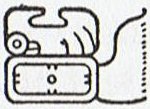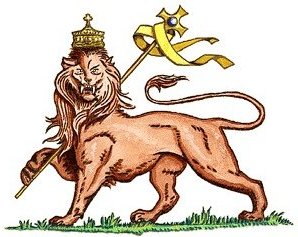20. Perhaps Raven was delayed
because he did not follow the smooth ecliptic path of the planets
(living stars) but instead flew along the flow of the
Milky Way river down towards
Eridu, The circle
offers the shortest and quickest path and if the Raven went some
other way he surely must become delayed:

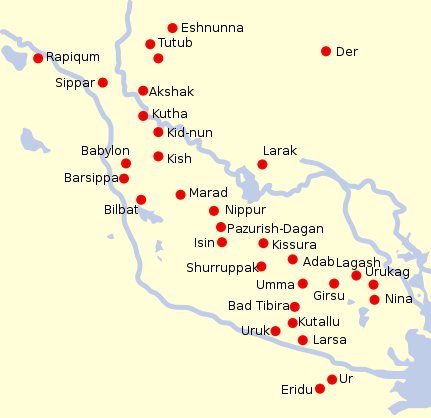

That could be why he was doomed to become everlasting thirsty.
... the bird, being sent with a cup for
water, loitered at a fig-tree till the fruit became ripe,
and then returned to the god with a water-snake in his claws
and a lie in his mouth, alleging the snake to have been the
cause of the delay. In punishment he was forever fixed in
the sky with the Cup and the Snake; and, we may infer,
doomed to everlasting thirst by the guardianship of the
Hydra over the Cup and its contents. From all this came
other poetical names for our Corvus - Avis Ficarius,
the Fig Bird; and Emansor, one who stays beyond his
time; and a belief, in early folk-lore, that this alone
among birds did not carry water to its young
...
... The Pythagoreans make Phaeton
fall into Eridanus, burning part of its
water, and glowing still at the time when
the Argonauts passed by. Ovid stated that
since the fall the Nile hides its sources.
Rigveda 9.73.3 says that the Great Varuna
has hidden the ocean. The Mahabharata tells
in its own style why the 'heavenly Ganga'
had to be brought down. At the end of the
Golden Age (Krita Yuga) a class of
Asura who had fought against the 'gods'
hid themselves in the ocean where the gods
could not reach them, and planned to
overthrow the government. So the gods
implored Agastya (Canopus, alpha
Carinae = Eridu) for help. The great Rishi did as he was
bidden, drank up the water of the ocean, and
thus laid bare the enemies, who were then slain by the gods.
But now, there was no ocean anymore! Implored by the gods to
fill the sea again, the Holy One replied: 'That water in
sooth hath been digested by me. Some other expedient,
therefore, must be thought of by you, if ye desire to make
endeavour to fill the ocean
...
... Eridhu,
or Eri-duga, the Holy City, Nunki, or Nunpe,
one of the oldest city in the world, even in ancient
Babylonia, was that kingdom's flourishing port on the
Persian Gulf, but, by the encroachments of the delta, its
site is now one hundred miles inland. In its vicinity the
Babylonians located their sacred Tree of Life ...
|
Egyptian cobra in
repose |
 |
Phoenician nūn |
 |
Greek
nu |
Ν (ν) |
|
... Nun is thought to have
come from a pictogram of a snake (the Hebrew word
for snake, nachash begins with a Nun
and snake in Aramaic is nun) or eel.
Some have hypothesized a hieroglyph
of a fish in water for its origin (in Arabic,
nūn means large fish or whale). The
Phoenician letter was named
nūn 'fish', but the glyph has been suggested
to descend from a hypothetical Proto-Canaanite
nahš 'snake', based on the name in
Ethiopic, ultimately from a hieroglyph representing
a snake.
... Nahš in modern Arabic literally
means 'bad luck'. The cognate letter in Ge'ez and
descended Semitic languages of Ethiopia is nehas,
which also means 'brass'. |
... This [σ
Sagittarii] has been identified with
Nunki of the
Euphratean Tablet of the Thirty Stars, the Star of
the Proclamation of the Sea, this Sea being the
quarter occupied by Aquarius, Capricornus, Delphinus,
Pisces, and Pisces Australis. It is the same space in the
sky that Aratos designated as Water
...

|
1 |
Al Sharatain |
Pair of Signs |
β Arietis (Sheratan),
γ (Mesarthim) |
27.4 |
April 17 (107) |
19 |
|
|
MUSCA
BOREALIS |
35 (Head of the Fly),
39 (Kaffaljidhma), and
41 Arietis (Bharani) |
41.4 |
May 1 (121) |
33 |
0 |
|
2 |
Al Dabarān |
Follower |
α Tauri (Aldebaran),
θ¹, θ²´,
γ (Hyadum I),
δ (Hyadum II), ε (Ain) |
63.4 |
May 23 (143) |
55 |
22 |
|
3 |
Al Hak'ah |
White Spot |
λ
Orionis (Heka),
φ¹,
φ² |
83.4 |
June 12 (163) |
75 |
42 |
|
4 |
Al Han'ah |
Brand |
γ Gemini (Alhena), μ
(Tejat Posterior), ν,
η (Tejat Prior),
ξ (Alzirr) |
93.4 |
June 22 (173) |
85 |
52 |
|
5 |
Al Dhirā' |
Forearm |
α Gemini (Castor),
β (Pollux) |
113.4 |
July 12 (193) |
105 |
72 |
|
6 |
Al Nathrah |
Gap |
ε Cancri (Beehive) |
130.4 |
July 29 (210) |
123 |
90 |
|
7 |
Al Tarf |
End |
ξ
Cancri,
λ
Leonis (Alterf) |
143.4 |
Aug 11 (223) |
135 |
102 |
|
8 |
Al Jabhah |
Forehead |
η Leonis (Al Jabhah),
α (Regulus), ζ
(Adhafera), γ (Algieba) |
152.4 |
Aug 20 (232) |
144 |
111 |
|
9 |
Al Zubrah |
Mane |
δ
Leonis (Zosma),
θ
(Coxa) |
169.4 |
Sept 6 (249) |
161 |
128 |
|
10 |
Al Sarfah |
Turn |
β Leonis (Denebola) |
178.3 |
Sept 15 (258) |
170 |
137 |
|
11 |
Al Áwwā' |
Barker |
β (Alaraph), η
(Zaniah),
γ (Porrima),
δ (Minelauva), ε
Virginis (Vindemiatrix) |
191.5 |
Sept 28 (271) |
183 |
150 |
|
Musca Borealis is
here not listed but only inferred,
because the above are Sun
stations carrying 150 days of summer.
Insects are normally not present in
winter time.
"[β] ... Zavijava,
a universal name in modern
catalogues, is first found with
Piazzi, but is Zarijan in the
Standard Dictionary. It is from
Al Zāwiah, the Angle, or Corner,
i.e. Kennel, of the Arab dogs, -
although γ exactly marks this Corner
and should bear the title." (Allen)
|
Egyptian sebchet |
 |
Phoenician
pe |
 |
Greek
pi |
Π
(π) |
|
Wikipedia: '...
according to a theory by
Theodor Nöldeke from
1904, some of the letter
names were changed in
Phoenician from the
Proto-Canaanite script
...
pit 'corner'
to pe 'mouth'
...'
However, I think the
Egyptian source
hieroglyph could
have been Gardiner's
O14 (sebchet),
a sign which
illustrates a corner
with feather-like
ornaments upon the
walls. The meaning
was 'portal'
according to
Wilkinson. Or why
not an Archway for
exit, the Mayas had
a 'grasping hand' (Chikin)
in the west:
To
be in a corner means
there is no way
forward.
|
|

Currently the equator in the sky was crossed by the
ecliptic plane around the northern autumn equinox instead of at spring equinox:

|
 |
*30 |
 |
*7 |
 |
*18 |
 |
|
Ga1-21 |
Ga2-22 (52) |
Ga3-1 (60) |
Ga3-20 (79) |
|
June 14 (*85) |
July 15 (*116) |
July 23 (*124) |
Aug 11 (*143) |
|
APRIL 11
(*21) |
MAY 12 (*52) |
MAY 20 (*60) |
JUNE 8 (*79) |
|
YANG MUN
(SOUTH GATE
OF THE WOLF)
"Nov 3 (*227) |
POLLUX (β) +
MARS
May 14
(*54) AD 2023
|
19 |
AL TARF (β) +
MARS
June 3
(*74) AD 2023 |
10 |
ALTERF (λ) +
MARS
June 14
(*85) AD 2023 |
|
32 |
|
"Dec 4 (*258) |
*7 |
"Dec 12 (*266) |
*18 |
*285 ("Dec 31) |
79 - 21
= 2 * 29 = 64 - 6 = 58 = 30 + 32 - 4
The
last glyph on side a of the G tablet is number
229, and 2 * 29 = 58 = 300 - 242 (number of
glyphs on side b of the G tablet).
... Ecclesiastically, the
equinox is reckoned to be on 21 March (even
though the equinox occurs, astronomically
speaking, on 20 March in most years) ...
|
|
JULY
15 |
16 |
17
(*118 → 4 * 29½) |
18 (199) |
 |
 |
 |
 |
|
Ga5-6 |
Ga5-7 |
Ga5-8
(118) |
Ga5-9 |
| |
π
Virginis (*181.0) |
|
ALCHITA |
|
*363 |
|
SIRRAH |
ALGENIB PEGASI |
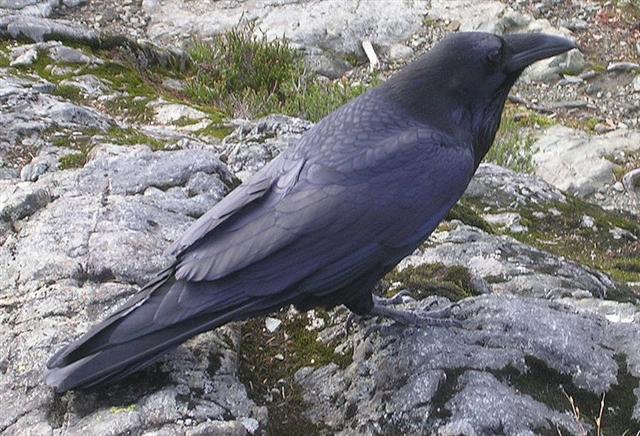 |
|
JULY 19
(200) |
20 (*121) |
 |
 |
|
Ga5-10
(120) |
Ga5-11 |
| |
σ
Andromedae (*3.0) |
|
Sept 21
(*184 = *120 + *64) |
Equinox
(265 = 236 + 29)
ZANIAH |
|
Viri.
1. To wind, to coil, to roll up; he
viri i te hau, to wind, coil a string
(to fasten something). 2. To fall from a
height, rolling over, to hurl down, to fling
down. Viriviri, round, spherical
(said of small objects). Viviri te
henua, to feel dizzy (also: mimiro te
henua). Vanaga. To turn in a circle, to
clew up, to groom, to twist, to dive from a
height, to roll (kaviri). Hakaviri,
crank, to groom, to turn a wheel, to
revolve, to screw, to beat down; kahu
hakaviri, shroud. Viriga,
rolling, danger. Viriviri, ball,
round, oval, bridge, roll, summit, shroud,
to twist, to wheel round, to wallow.
Hakaviriviri, to roll, to round; rima
hakaviriviri, stroke of the flat,
fisticuff. P Pau.: viriviri, to
brail, to clew up; koviriviri,
twisting. Mgv.: viri, to roll, to
turn, to twist; viviri, to fall to
the ground again and again in a fight. Mq.:
vii, to slide, to roll, to fall and
roll. Ta.: viri, to roll up, to clew
up. Viritopa, danger. Mgv.:
Viripogi, eyes heavy with sleep. Mq.:
viipoki, swooning, vertigo. Churchill.
Viti: vili, to pick up fallen fruit
or leaves ... In Viti virimbai has
the meaning of putting up a fence (mbai
fence); viri does not appear
independently in this use, but it is
undoubtedly homogenetic with Samoan vili,
which has a basic meaning of going around;
virikoro then signifies the
ring-fence-that-goes-about, sc. the moon. In
the Maori, aokoro is the cloud-fence
... Churchill 2. |
|
JULY 21 |
7-22 (*123) |
23 |
24 |
25 |
 |
 |
 |
 |
 |
|
Ga5-12 |
Ga5-13 (123) |
Ga5-14 |
Ga5-15 |
Ga5-16 |
| |
ANKAA (*5.0) |
|
|
SCHEDIR |
|
LONG SANDBANK |
ACRUX |
γ Com.
Berenicis (*188.0) |
γ Muscae
(*189.0) |
|
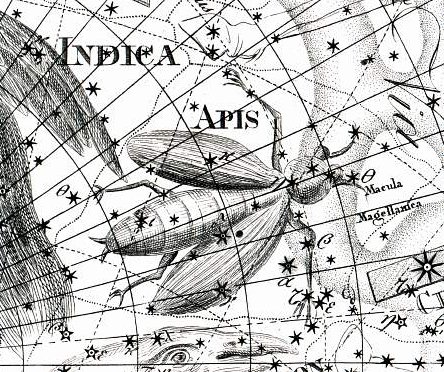 |
|
JULY 26 |
27 |
28 |
29 (210) |
30 |
 |
 |
 |
 |
 |
|
Ga5-17 |
Ga5-18 (128) |
Ga5-19 |
Ga5-20 |
Ga5-21 |
|
ξ Phoenicis
(*9.0) |
|
η Andromedae
(*11.4) |
CIH (*12.4) |
|
|
PORRIMA |
|
|
ALIOTH |
JAN 29 (*314) |
 |
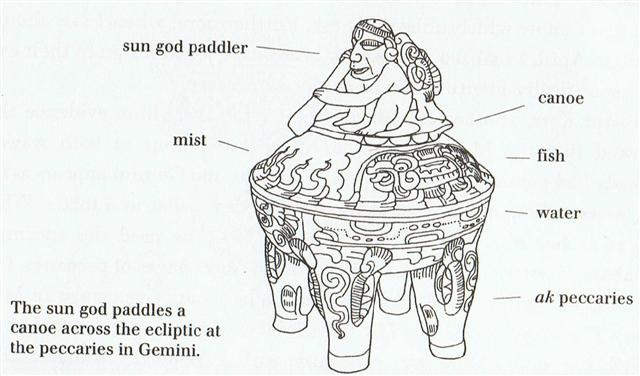
|





